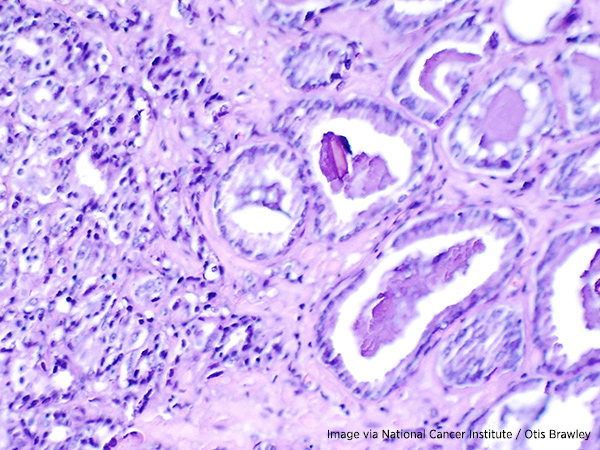A New PARP Inhibitor Combination for Metastatic Prostate Cancer
The FDA approved the PARP inhibitor talazoparib in combination with hormone therapy for metastatic prostate cancer
The U.S. Food and Drug Administration (FDA) has approved talazoparib (Talzenna) in combination with the antiandrogen therapy enzalutamide (Xtandi) for the treatment of patients with metastatic, castration-resistant prostate cancer (mCRPC) whose tumors harbor mutations in genes involved in a DNA repair mechanism called homologous recombination repair (HRR).
Talazoparib belongs to a class of targeted therapies known as poly (ADP-ribose) polymerase (PARP) inhibitors. The PARP enzyme is essential for repairing a certain type of DNA damage that affects one strand of the double helix. If left unrepaired, this type of lesion is converted into double-strand DNA damage, which requires the HRR mechanism to be repaired. In cells with defective HRR due to gene mutations, treatment with PARP inhibitors leads to excessive DNA damage and cell death.

Enzalutamide is an androgen receptor inhibitor used for the treatment of prostate cancer. It works by blocking the effects of androgen hormones, which drive the growth of prostate cancer cells.
Another combination therapy involving a PARP inhibitor and an antiandrogen therapy, olaparib (Lynparza) plus abiraterone (Zytiga) and a corticosteroid, was recently approved for patients with mCRPC harboring certain genetic defects. Olaparib and another PARP inhibitor, rucaparib (Rubraca), are also approved to treat certain mCRPCs after progression on antiandrogen therapy.
The approval of the talazoparib and enzalutamide combination was based on results from TALAPRO-2, a phase III randomized, double-blind, placebo-controlled, multi-cohort trial that enrolled 399 patients with HRR gene-mutated mCRPC who had undergone surgical or chemical castration and had not been treated with prior systemic therapy for their mCRPC. Patients were randomly assigned (1:1) to receive either enzalutamide plus talazoparib or enzalutamide plus placebo.
Treatment with talazoparib and enzalutamide led to a statistically significant improvement in radiographic progression-free survival (rPFS) compared to enzalutamide alone. Patients who received the combination therapy had their risk of disease progression or death decreased by 55%. The investigators also analyzed efficacy based on mutation status of the BRCA genes, which are critical players in the HRR pathway and are implicated in prostate and other cancers, and found that the risk reduction associated with the combination treatment was 80% among patients with BRCA-mutated mCRPC and 28% among those without the mutations.
Prostate cancer accounts for 14.7% of all new cancer cases in the U.S. According to federal statistics, about 288,300 individuals will be diagnosed with prostate cancer and 34,700 patients will die of the disease in the U.S. in 2023.
The FDA rendered its decision on June 20, 2023.
